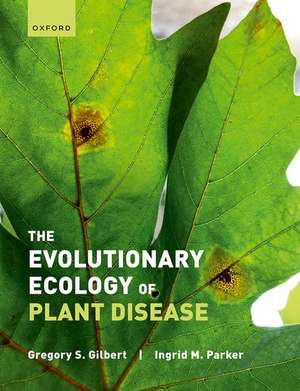The Evolutionary Ecology of Plant Disease
Autor Gregory Gilbert, Ingrid Parkeren Limba Engleză Paperback – 16 mai 2023
| Toate formatele și edițiile | Preț | Express |
|---|---|---|
| Paperback (1) | 287.27 lei 10-16 zile | +60.83 lei 7-13 zile |
| OUP OXFORD – 16 mai 2023 | 287.27 lei 10-16 zile | +60.83 lei 7-13 zile |
| Hardback (1) | 605.37 lei 10-16 zile | +134.88 lei 7-13 zile |
| OUP OXFORD – 16 mai 2023 | 605.37 lei 10-16 zile | +134.88 lei 7-13 zile |
Preț: 287.27 lei
Preț vechi: 314.42 lei
-9% Nou
Puncte Express: 431
Preț estimativ în valută:
54.97€ • 57.51$ • 45.66£
54.97€ • 57.51$ • 45.66£
Carte disponibilă
Livrare economică 01-07 martie
Livrare express 26 februarie-04 martie pentru 70.82 lei
Preluare comenzi: 021 569.72.76
Specificații
ISBN-13: 9780198797883
ISBN-10: 0198797885
Pagini: 336
Dimensiuni: 190 x 246 x 17 mm
Greutate: 0.74 kg
Editura: OUP OXFORD
Colecția OUP Oxford
Locul publicării:Oxford, United Kingdom
ISBN-10: 0198797885
Pagini: 336
Dimensiuni: 190 x 246 x 17 mm
Greutate: 0.74 kg
Editura: OUP OXFORD
Colecția OUP Oxford
Locul publicării:Oxford, United Kingdom
Recenzii
This is a true learning tool. I can't wait to use it in introductory plant pathology courses and to share it with the public when they say, "You're a what? Plant pathologist?"
Essential reading for students of all levels: from the scientifically curious layperson to the seasoned specialist.
This treatise is impressive in its comprehensive and understandable introduction to the basic biology of diverse plant pathogens, and the complex interactions that they have with their plant hosts. There is a lot to learn and think about in this book!
The Evolutionary Ecology of Plant Disease successfully bridges the disciplines of disease evolutionary ecology and plant pathology. It should serve as a very good textbook for undergraduate and graduate students, as a resource for ecologists studying plant diseases, and for plant pathologists.
This is an easy-to-read book that merges current knowledge of plant pathology and evolutionary ecology, while describing basic concepts in simple terms...[It's] a great resource for educators and students in plant pathology and mycology and provides a refreshing perspective by going beyond agricultural settings to exploring the role of plant disease in natural ecosystems.
This book has clear yet concise details and takes the reader through the course at an achievable pace. There are colourful illustrations, useful learning tips such as a mnemonic to remember rust spore types and insert boxes to highlight key processes or techniques, such as serological testing using ELISA. To help non-experts, there are primers on some mathematical analyses such as population models. New terms are highlighted in bold; a glossary of these words would be a useful addition.
Essential reading for students of all levels: from the scientifically curious layperson to the seasoned specialist.
This treatise is impressive in its comprehensive and understandable introduction to the basic biology of diverse plant pathogens, and the complex interactions that they have with their plant hosts. There is a lot to learn and think about in this book!
The Evolutionary Ecology of Plant Disease successfully bridges the disciplines of disease evolutionary ecology and plant pathology. It should serve as a very good textbook for undergraduate and graduate students, as a resource for ecologists studying plant diseases, and for plant pathologists.
This is an easy-to-read book that merges current knowledge of plant pathology and evolutionary ecology, while describing basic concepts in simple terms...[It's] a great resource for educators and students in plant pathology and mycology and provides a refreshing perspective by going beyond agricultural settings to exploring the role of plant disease in natural ecosystems.
This book has clear yet concise details and takes the reader through the course at an achievable pace. There are colourful illustrations, useful learning tips such as a mnemonic to remember rust spore types and insert boxes to highlight key processes or techniques, such as serological testing using ELISA. To help non-experts, there are primers on some mathematical analyses such as population models. New terms are highlighted in bold; a glossary of these words would be a useful addition.
Notă biografică
Gregory S. Gilbert is Professor in the Department of Environmental Studies, University of California Santa Cruz, USA. He is a plant pathologist and forest ecologist, and his research interests include the dynamics of plant and fungal communities, as well as the application of evolutionary ecology to environmental problem solving. He is the Director of the UCSC Forest Ecology Research Plot, and is a Research Associate at the Smithsonian Tropical Research Institute, Panama.Ingrid M. Parker is Professor in the Department of Ecology and Evolutionary Biology, University of California Santa Cruz, USA. She is a plant evolutionary ecologist, and her research interests include plant disease ecology, the invasion of non-native species, the evolution of domestication, ecological restoration, and plant conservation. She is a Research Associate at the Smithsonian Tropical Research Institute, Panama.
